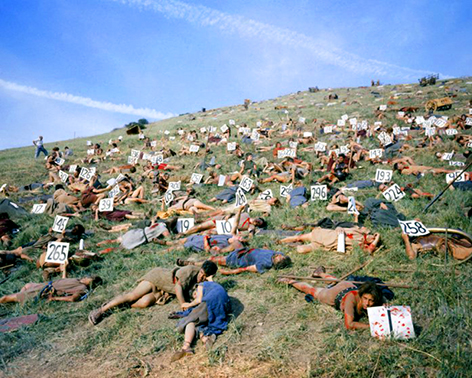
3. We are Spartacus
There’s a photograph amongst the publicity stills from the shooting of Spartacus, of a small group of local children hanging around the set. It’s a great image. The children crowd into the frame. Only one boy beams as he’s supposed to because he’s having his picture taken. The others simply look towards the camera with a shared curiosity about being the sudden focus of the photographer’s gaze. There’s a very particular gender stratification to the image. Boys cluster round the photographer in the foreground of the frame, girls stand apart looking on more speculatively at the back of the group. This particularity marks the image out. It speaks a time and a place. It speaks of a world organised differently from the world of the film set and its temporariness.
I like production stills. I like the mess of people they reveal, the way they capture the intensity of activity that goes into the making of the smoothed-out image we eventually see on screen. There’s a different image in the same collection, of Kubrick standing like Nelson on his column high up above the set on the platform of a kind of improvised fork-lift truck; Kubrick, his camera, his cameraman, in a different sphere to the landscape and the crew below. Where Kubrick is intent, focussed on looking beyond what is revealed by the frame of the image, the crew, like the crowd at the bottom of a cross in a Medieval religious painting, are somehow trapped in their own obliviousness. On one hand there’s the intensity of vision. On the other there’s the self-involvement of the social world. Like the image of the children instinctively standing in gendered hierarchy, this image reveals the social stratification operating on the set.
It’s easy to forget about the social and political conditions that frame the creation of any finished moving image work. On the one hand there’s vision, on the other the crowd, the workers, the audience, spectators, witnesses. Here, in the first image I mentioned, the children on Spartacus’ set are the spectators to the event of filmmaking. The children’s presence, the real life that they represent, is a welcome disruption to the unreal world many of the stills manage to capture.
What is invisible when watching the finished version of Spartacus is that part of the film was made in Spain, in Franco’s Spain, the home of these children, at a time when most of the other countries in Western Europe were celebrating an end to dictatorship in a new, post-war form of consciousness of what it had meant to live life under extremist ideology. But here, in galling irony, in a country still under military rule, Spanish soldiers are being recruited by the production team to fight the film’s battle scenes. Where Spartacus requires the Roman army to crush the slave resisters on the side of Vesuvius, in a field outside Madrid in the nineteen-fifties contemporary Spanish soldiers swell the number of extras to perform the act of oppression. Roman soldiers. Spanish soldiers. Slave resisters. Circumspect children. Here is a strange collision: the gestures of power, and the gestures of resistance.
I’m looking at these stills in the week when the President of the United States is spluttering indignation about the resistance of African-American sportsmen who kneel instead of salute the American flag during the national anthem at sporting events.
I think of America’s cycles of oppression. In amongst the production stills are a sequence of images shot in fact by Kubrick himself of Dalton Trumbo, the writer who wrote many of Hollywood’s greatest films under a pseudonym because of his blacklisting by the McCarthy purge on ‘un-American’ public figures. Trumbo’s talent wasn’t blocked by this. He carried on writing using pseudonyms and proxies. The fact that he was named on the 1960 release of Spartacus was an action that publicly marked the death throes of the control of McCarthyism.
The images, the evidence of Trumbo’s real presence on set, recorded by Kubrick and held in the chronology a contact sheet represents, works on me like a time bomb of meaning. Here in the archival is a gesture of resistance – both in Trumbo’s presence and in Kubrick’s recording of Trumbo’s presence. The image works as a promise to future viewers that times of oppression will be witnessed, and will pass.